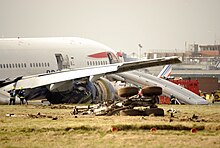British Airways Flight 38

G-YMMM after the crash at London Heathrow Airport.
|
|
| Accident summary | |
|---|---|
| Date | 17 January 2008 |
| Summary | Fuel starvation caused by ice, crashed short of runway |
| Site |
London Heathrow Airport, United Kingdom 51°27′54″N 0°25′54″W / 51.46500°N 0.43167°WCoordinates: 51°27′54″N 0°25′54″W / 51.46500°N 0.43167°W |
| Passengers | 136 |
| Crew | 16 |
| Fatalities | 0 |
| Injuries (non-fatal) | 47 (including 1 serious) |
| Survivors | 152 (all) |
| Aircraft type | Boeing 777-236ER |
| Operator | British Airways |
| Registration | G-YMMM |
| Flight origin | Beijing Capital International Airport |
| Destination | London Heathrow Airport |
British Airways Flight 38 (call sign Speedbird 38) is a scheduled flight operated by British Airways from Beijing, China to London, United Kingdom. On 17 January 2008, local time 12:32 GMT, the Boeing 777 used for the flight, having completed the 8,100-kilometre (4,400 nmi; 5,000 mi) trip, crashed just short of the runway at its destination. There were no fatalities but from the 152 people on board, 47 people sustained injuries, one of them serious. The 150-tonne aircraft was the first Boeing 777-200ER to be written off in the model's history, and the first hull loss of any Boeing 777.
Ice crystals in the fuel were blamed as the cause of the accident, clogging the fuel-oil heat exchanger (FOHE) of each engine. This restricted fuel flow to the engines when thrust was demanded during the final approach to Heathrow. Boeing identified the problem as specific to the Rolls-Royce engine fuel-oil heat exchangers, and Rolls-Royce subsequently developed a modification to its FOHE; the European Aviation Safety Agency (EASA) mandated that all affected aircraft were to be fitted with the modification before 1 January 2011.
The aircraft used for the flight was Boeing 777-236ER G-YMMM (manufacturer's serial number 30314, line number 342), powered by two Rolls-Royce Trent 895-17 engines. The aircraft first flew on 18 May 2001 and was delivered to British Airways on 31 May 2001. It had a seating capacity for 233 passengers.
Flight 38's route took it over Mongolia, Siberia and Scandinavia, at an altitude which varied between 34,800 and 40,000 ft (FL348–400, between 10,600 and 12,200 m), and in temperatures between −65 and −74 °C. Aware of the cold conditions outside, the crew monitored the temperature of the fuel, with the intention of descending to a lower, warmer, level if there was any danger of the fuel freezing. This did not prove necessary, as the fuel temperature never dropped below −34 °C, still well above its freezing point.
...
Wikipedia
